代码随想录算法训练营Day16| 104. 二叉树的最大深度、559.n叉树的最大深度、111. 二叉树的最小深度、222. 完全二叉树的节点个数
代码随想录算法训练营Day16| 104. 二叉树的最大深度、559.n叉树的最大深度、111. 二叉树的最小深度、222. 完全二叉树的节点个数
104. 二叉树的最大深度
而根节点的高度就是二叉树的最大深度。
①递归法
我们使用「左右中」的后序遍历方式求根节点的高度。
/**
* Definition for a binary tree node.
* struct TreeNode {
* int val;
* TreeNode *left;
* TreeNode *right;
* TreeNode() : val(0), left(nullptr), right(nullptr) {}
* TreeNode(int x) : val(x), left(nullptr), right(nullptr) {}
* TreeNode(int x, TreeNode *left, TreeNode *right) : val(x), left(left), right(right) {}
* };
*/
class Solution {
public:
int maxDepth(TreeNode* root) {
return searchMaxDepth(root);
}
int searchMaxDepth(TreeNode* node) {
if (node == NULL) return 0;
int leftDepth = searchMaxDepth(node->left);
int rightDepth = searchMaxDepth(node->right);
return max(leftDepth, rightDepth) + 1;
}
};
②迭代法
使用层序遍历是最为合适的,因为最大的深度就是二叉树的层数,和层序遍历的方式极其吻合。
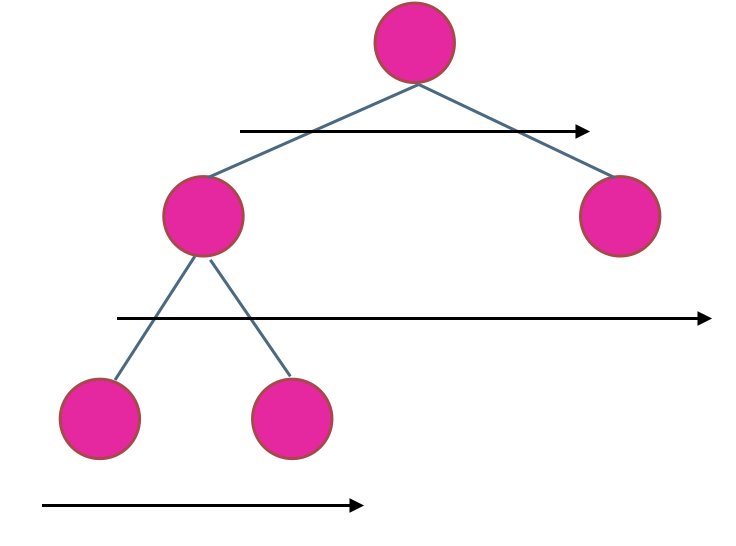
代码如下:
/**
* Definition for a binary tree node.
* struct TreeNode {
* int val;
* TreeNode *left;
* TreeNode *right;
* TreeNode() : val(0), left(nullptr), right(nullptr) {}
* TreeNode(int x) : val(x), left(nullptr), right(nullptr) {}
* TreeNode(int x, TreeNode *left, TreeNode *right) : val(x), left(left), right(right) {}
* };
*/
class Solution {
public:
int maxDepth(TreeNode* root) {
queue<TreeNode*> que;
if (root == NULL) return 0;
else que.push(root);
int res = 0;
while (!que.empty()) {
int size = que.size();
res++; // 记录深度
while (size--) {
TreeNode* node = que.front();
que.pop();
if (node->left) que.push(node->left);
if (node->right) que.push(node->right);
}
}
return res;
}
};
559.n叉树的最大深度
将二叉树的情况推广到n叉树,思路类似。
①递归法
/*
// Definition for a Node.
class Node {
public:
int val;
vector<Node*> children;
Node() {}
Node(int _val) {
val = _val;
}
Node(int _val, vector<Node*> _children) {
val = _val;
children = _children;
}
};
*/
class Solution {
public:
int maxDepth(Node* root) {
return searchMaxDepth(root);
}
int searchMaxDepth(Node* node) {
if (node == NULL) return 0;
int maxDepth = 0;
for (Node* child : node->children) {
int tmp = searchMaxDepth(child);
maxDepth = tmp > maxDepth ? tmp : maxDepth;
}
return maxDepth + 1;
}
};
②迭代法
/*
// Definition for a Node.
class Node {
public:
int val;
vector<Node*> children;
Node() {}
Node(int _val) {
val = _val;
}
Node(int _val, vector<Node*> _children) {
val = _val;
children = _children;
}
};
*/
class Solution {
public:
int maxDepth(Node* root) {
queue<Node*> que;
if (root == NULL) return 0;
else que.push(root);
int res = 0;
while (!que.empty()) {
int size = que.size();
res++;
while (size--) {
Node* node = que.front();
que.pop();
for (Node* child : node->children) {
if (child) que.push(child);
}
}
}
return res;
}
};
111. 二叉树的最小深度
本题有一个误区,在处理节点的过程中,最大深度很容易理解,最小深度就不那么好理解,如图:
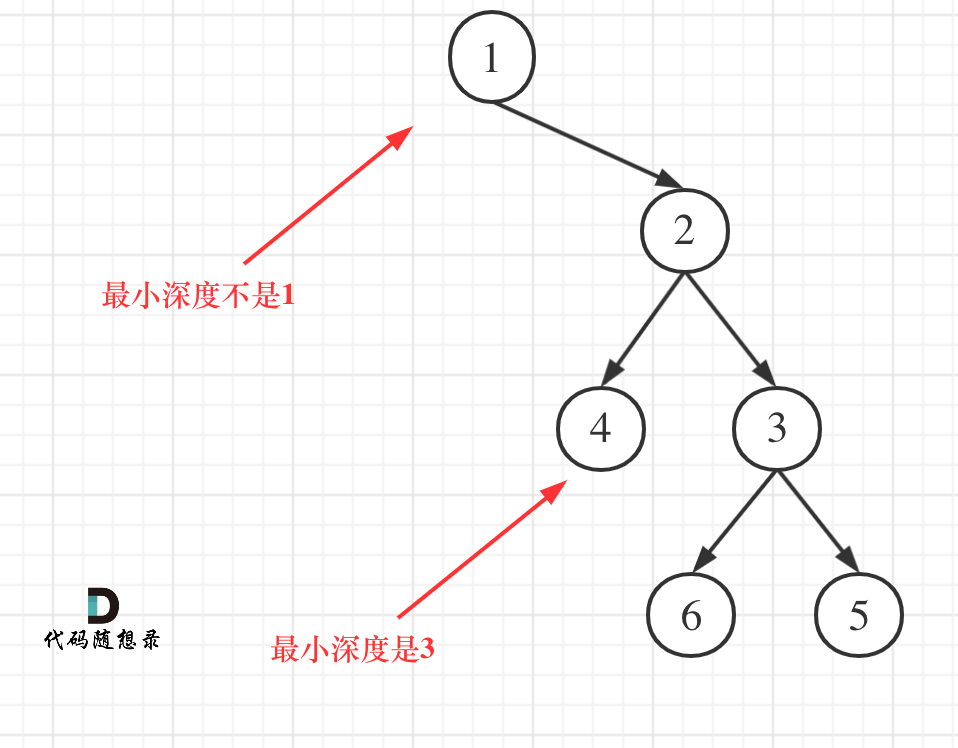
最小深度是从根节点到最近叶子节点的最短路径上的节点数量,注意终点是叶子节点。(左右孩子节点必须为空!)
①递归法
递归首先确定递归的三步骤:
- 确定递归函数的参数和返回值
参数为要传入的二叉树根节点,返回的是int类型的深度。代码如下:
int getDepth(TreeNode* node)
- 确定终止条件
终止条件也是遇到空节点返回0,表示当前节点的高度为0。代码如下:
if (node == NULL) return 0;
- 确定单层递归的逻辑
这块和求最大深度可就不一样了,一些同学可能会写如下代码:
int leftDepth = getDepth(node->left);
int rightDepth = getDepth(node->right);
int result = 1 + min(leftDepth, rightDepth);
return result;
如果这么求的话,没有左孩子的分支会算为最短深度。所以需要对左右孩子是否为空进行讨论:
-
所以,如果左子树为空,右子树不为空,说明最小深度是 1 + 右子树的深度。
-
反之,右子树为空,左子树不为空,最小深度是 1 + 左子树的深度。 最后如果左右子树都不为空,返回左右子树深度最小值 + 1 。
完整代码如下:
/**
* Definition for a binary tree node.
* struct TreeNode {
* int val;
* TreeNode *left;
* TreeNode *right;
* TreeNode() : val(0), left(nullptr), right(nullptr) {}
* TreeNode(int x) : val(x), left(nullptr), right(nullptr) {}
* TreeNode(int x, TreeNode *left, TreeNode *right) : val(x), left(left), right(right) {}
* };
*/
class Solution {
public:
int minDepth(TreeNode* root) {
return getMinDepth(root);
}
int getMinDepth(TreeNode* node) {
if (node == NULL) return 0;
int leftDepth = getMinDepth(node->left);
int rightDepth = getMinDepth(node->right);
// 要考虑孩子节点为空的情况
if (node->left == NULL && node->right != NULL) return rightDepth + 1;
if (node->left != NULL && node->right == NULL) return leftDepth + 1;
return min(leftDepth, rightDepth) + 1;
}
};
②迭代法
层序遍历即可,重点在于判断最小深度的时机:只有当左右孩子都为空的时候,才说明遍历的最低点了。如果其中一个孩子为空则不是最低点。代码如下:
/**
* Definition for a binary tree node.
* struct TreeNode {
* int val;
* TreeNode *left;
* TreeNode *right;
* TreeNode() : val(0), left(nullptr), right(nullptr) {}
* TreeNode(int x) : val(x), left(nullptr), right(nullptr) {}
* TreeNode(int x, TreeNode *left, TreeNode *right) : val(x), left(left), right(right) {}
* };
*/
class Solution {
public:
int minDepth(TreeNode* root) {
queue<TreeNode*> que;
if (root == NULL) return 0;
else que.push(root);
int res = 0;
while (!que.empty()) {
int size = que.size();
res++;
while (size--) {
TreeNode* node = que.front();
que.pop();
if (node->left == NULL && node->right == NULL) return res;
if (node->left) que.push(node->left);
if (node->right) que.push(node->right);
}
}
return res;
}
};
222. 完全二叉树的节点个数
普通二叉树——递归法
首先按照普通二叉树的逻辑来求。
这道题目的递归法和求二叉树的深度写法类似, 而迭代法二叉树的层序遍历.html)遍历模板稍稍修改一下,记录遍历的节点数量就可以了。代码如下:
/**
* Definition for a binary tree node.
* struct TreeNode {
* int val;
* TreeNode *left;
* TreeNode *right;
* TreeNode() : val(0), left(nullptr), right(nullptr) {}
* TreeNode(int x) : val(x), left(nullptr), right(nullptr) {}
* TreeNode(int x, TreeNode *left, TreeNode *right) : val(x), left(left), right(right) {}
* };
*/
class Solution {
public:
int countNodes(TreeNode* root) {
return getNodeNum(root);
}
int getNodeNum(TreeNode* node) {
if (node == NULL) return 0;
int leftNum = getNodeNum(node->left);
int rightNum = getNodeNum(node->right);
return leftNum + rightNum + 1;
}
};
普通二叉树——层序遍历法
使用层序遍历的模板即可。
/**
* Definition for a binary tree node.
* struct TreeNode {
* int val;
* TreeNode *left;
* TreeNode *right;
* TreeNode() : val(0), left(nullptr), right(nullptr) {}
* TreeNode(int x) : val(x), left(nullptr), right(nullptr) {}
* TreeNode(int x, TreeNode *left, TreeNode *right) : val(x), left(left), right(right) {}
* };
*/
class Solution {
public:
int countNodes(TreeNode* root) {
queue<TreeNode*> que;
if (root == NULL) return 0;
else que.push(root);
int res = 0;
while (!que.empty()) {
int size = que.size();
res += size;
while (size--) {
TreeNode* node = que.front();
que.pop();
if (node->left) que.push(node->left);
if (node->right) que.push(node->right);
}
}
return res;
}
};
完全二叉树性质
首先我们需要熟悉完全二叉树的定义:完全二叉树的定义如下:在完全二叉树中,除了最底层节点可能没填满外,其余每层节点数都达到最大值,并且最下面一层的节点都集中在该层最左边的若干位置。
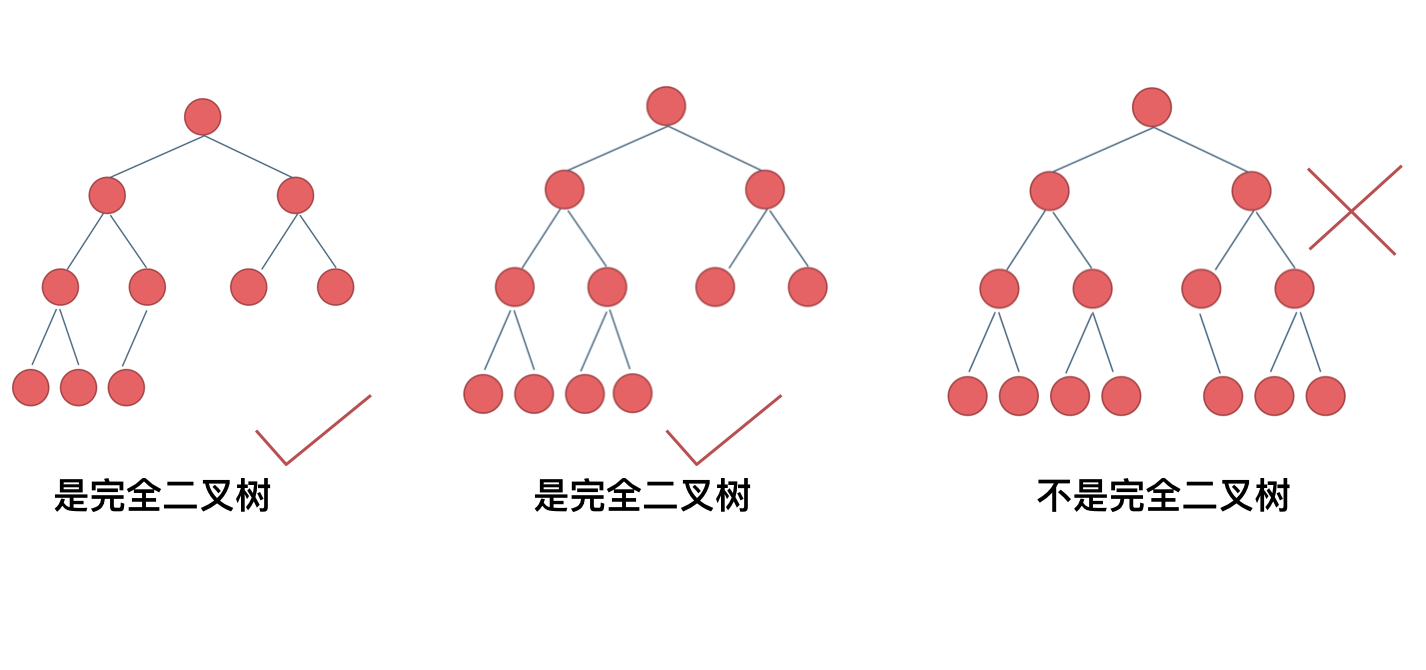
该定义表明,遍历一棵完全二叉树的左孩子节点,即可获得树根节点的深度。
int countDepth(TreeNode* node) {
int depth = 0;
while (node) {
node = node->left;
depth++;
}
return depth;
}
另外还有些性质包括:
-
满二叉树一共包含
2^depth-1个节点 -
若最底层为第 h 层,则该层包含
1~ 2^(h-1)个节点。 -
完全二叉树除最底层外,上层即为满二叉树
本题解法
完全二叉树只有两种情况,情况一:就是满二叉树,情况二:最后一层叶子节点没有满。
-
对于情况一,可以直接用 2^树深度 - 1 来计算,注意这里根节点深度为1。
-
对于情况二,分别递归左孩子,和右孩子,递归到某一深度一定会有左孩子或者右孩子为满二叉树,然后依然可以按照情况1来计算。
这里我们可以对左海孩子的深度进行比较:
- 如果根节点的左子树深度等于右子树深度,则说明左子树为满二叉树
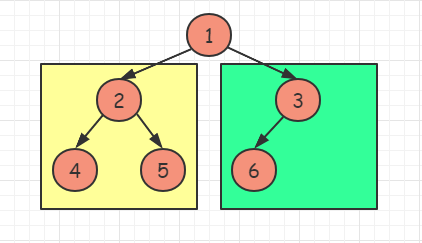
- 如果根节点的左子树深度大于右子树深度,则说明右子树为满二叉树
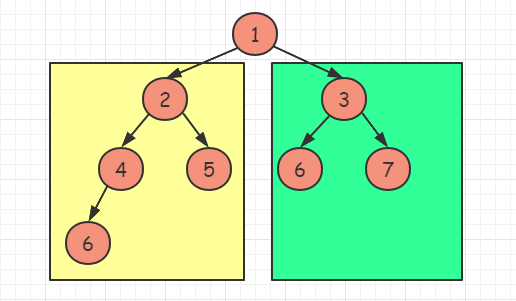
如果知道子树是满二叉树,那么就可以轻松得到该子树的节点数目,为了加快幂的运算速度,可以使用移位操作符:
(1<<depth) - 1; // depth为子树的深度;
完整代码如下:
/**
* Definition for a binary tree node.
* struct TreeNode {
* int val;
* TreeNode *left;
* TreeNode *right;
* TreeNode() : val(0), left(nullptr), right(nullptr) {}
* TreeNode(int x) : val(x), left(nullptr), right(nullptr) {}
* TreeNode(int x, TreeNode *left, TreeNode *right) : val(x), left(left), right(right) {}
* };
*/
class Solution {
public:
int countDepth(TreeNode* node) {
int depth = 0;
while (node) {
node = node->left;
depth++;
}
return depth;
}
int countNodes(TreeNode* root) {
if (root == NULL) return 0;
int leftDepth = countDepth(root->left);
int rightDepth = countDepth(root->right);
if (leftDepth == rightDepth) return (1 << leftDepth) + countNodes(root->right);
else return (1 << rightDepth) + countNodes(root->left);
}
};

